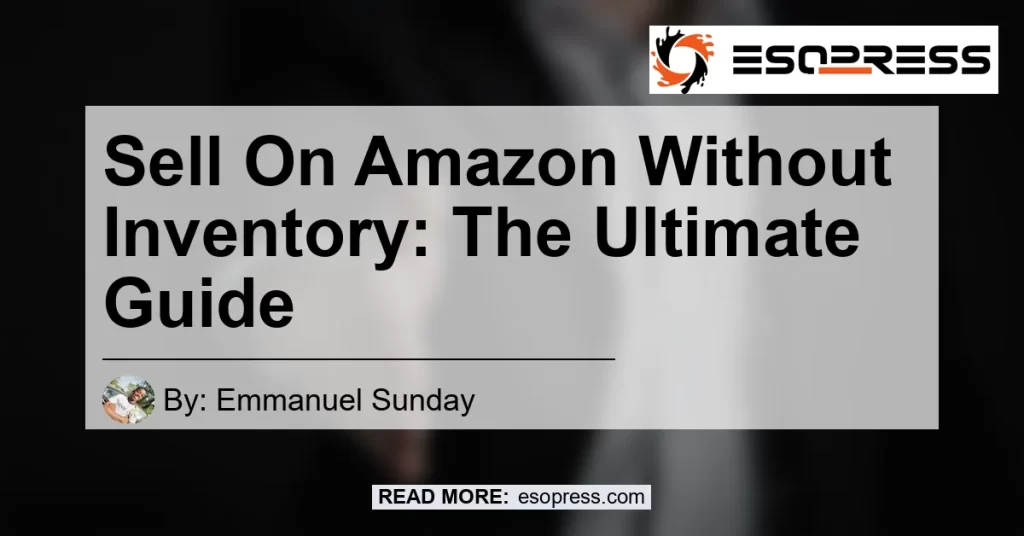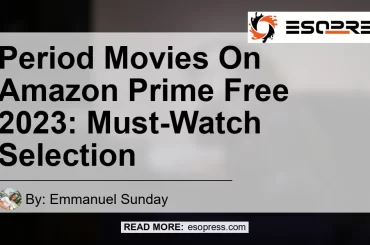
Selling on Amazon has become a lucrative opportunity for many entrepreneurs and businesses. However, one common barrier to entry is the need for inventory.
Fortunately, there are various methods and strategies that allow you to sell on Amazon without the need to hold physical inventory. In this comprehensive guide, we will explore the best practices and options for selling on Amazon without inventory, including print-on-demand, dropshipping, FBA (Fulfillment by Amazon), and FBM (Fulfillment by Merchant).
Check out this YouTube video titled “How To Sell On Amazon WITHOUT Buying ANY Inventory…” if you want to learn how to sell on Amazon without the need for inventory.
Contents
Introduction to Selling on Amazon Without Inventory
Selling on Amazon without inventory opens up a world of opportunities for entrepreneurs. By leveraging various methods and partnerships, you can tap into the massive customer base and fulfillment capabilities of Amazon without the need to handle and store physical products.
This guide will provide you with valuable insights and step-by-step instructions on how to get started and succeed in selling on Amazon without inventory.
Method 1: Print-on-Demand
Print-on-demand (POD) is a popular method for selling on Amazon without inventory. With POD, you can create custom-designed apparel and merchandise featuring your unique designs.
Merch by Amazon is a leading print-on-demand platform launched by Amazon itself. It allows individuals and businesses to design, create, and sell a wide range of products, including t-shirts, hoodies, mugs, and more.
The best part is that you don’t need to hold any inventory. When a customer places an order, the product is printed and shipped directly to them by Amazon.
Pros of Print-on-Demand:
- No need to hold any inventory.
- Low upfront costs as you only pay for products once they are sold.
- Easy to create and sell custom designs.
- Amazon takes care of the printing, packaging, and shipping process.
Cons of Print-on-Demand:
- Limited control over the production and fulfillment process.
- Higher competition as many sellers use this method.
To start selling on Amazon using print-on-demand, sign up for a Merch by Amazon account, create your designs, and upload them to the platform. Optimize your listings with relevant keywords, high-quality images, and compelling product descriptions to increase visibility and attract customers.
Method 2: Dropshipping
Dropshipping is another method that allows you to sell on Amazon without inventory. With dropshipping, you partner with suppliers or manufacturers who handle the inventory and shipping process.
When a customer places an order on Amazon, you simply forward the order details to your supplier, who then fulfills and ships the products directly to the customer. You don’t need to handle any inventory or worry about shipping logistics.
Pros of Dropshipping:
- No need to hold any inventory or handle shipping logistics.
- Wide range of products available for sale.
- Allows for flexibility and scalability.
Cons of Dropshipping:
- Lower profit margins due to the need to pay the supplier for each order.
- Limited control over the shipping and fulfillment process.
- Potential issues with product quality and customer satisfaction if the supplier is unreliable.
To start dropshipping on Amazon, you need to find reliable suppliers and establish partnerships with them. Platforms like Alibaba.com can help you connect with suppliers who offer dropshipping services.
Carefully research and vet potential suppliers to ensure they meet your quality standards and can fulfill orders in a timely manner.
Method 3: FBA (Fulfillment by Amazon)
Fulfillment by Amazon (FBA) is a program offered by Amazon that allows you to leverage their extensive fulfillment network. With FBA, you send your inventory to Amazon’s fulfillment centers, and they take care of the picking, packing, and shipping process.
When a customer places an order, Amazon handles all the logistics, including customer service and returns. This method provides a hands-off approach to selling on Amazon without the need to handle inventory or fulfillment.
Pros of FBA:
- Amazon handles the fulfillment process, including picking, packing, and shipping.
- Prime eligibility, which can attract more customers.
- Access to Amazon’s customer service and returns process.
- Higher chances of winning the Buy Box, which can lead to increased sales.
Cons of FBA:
- Cost of fulfilling and storing inventory in Amazon’s fulfillment centers.
- Potential storage fees if your products don’t sell quickly.
- Limited control over packaging and branding.
To get started with FBA, you need to create an Amazon Seller account and enroll in the FBA program. Prepare your inventory and ship it to Amazon‘s fulfillment centers.
Optimize your product listings with high-quality images, detailed descriptions, and relevant keywords to increase visibility and sales.
Method 4: FBM (Fulfillment by Merchant)
Fulfillment by Merchant (FBM) is an alternative to FBA, where you handle the fulfillment process yourself. With FBM, you hold the inventory and are responsible for picking, packing, and shipping the products when orders are placed.
While FBM requires more effort and resources compared to FBA, it offers more control over the fulfillment process.
Pros of FBM:
- More control over the fulfillment process and customer experience.
- Lower fulfillment costs as you don’t need to pay Amazon’s fees.
- Flexibility to handle unique or oversized products.
Cons of FBM:
- More time and effort required to handle fulfillment and shipping.
- Limited eligibility for Prime shipping.
- Potential challenges with customer service and returns.
To use FBM on Amazon, you need to configure your Amazon Seller account for FBM fulfillment. Create product listings in Seller Central, provide all the necessary details, and establish your shipping and fulfillment processes.
Optimize your product listings to attract customers and increase sales.
Best Practices for Selling on Amazon Without Inventory
To succeed in selling on Amazon without inventory, it’s important to follow these best practices:
-
Choose Your Suppliers Carefully: Whether you’re dropshipping, using FBA, or FBM with a third-party logistics provider (3PL), the reliability and quality of your supplier play a significant role. Do thorough research and vetting to ensure you partner with reputable suppliers.
-
Manage Your Inventory Effectively: If you choose to hold inventory for FBA or FBM, it’s crucial to manage your stock levels efficiently. Avoid overstocking or running out of popular products by analyzing sales data and forecasting demand.
-
Optimize Your Listings: Improve the visibility and ranking of your products by optimizing your listings with relevant keywords, high-quality images, detailed descriptions, and competitive pricing.
-
Provide Excellent Customer Service: Prioritize customer satisfaction by offering responsive customer support, addressing inquiries and issues promptly, and providing clear and transparent communication throughout the buying process.
Conclusion:
Selling on Amazon without inventory opens up numerous opportunities for entrepreneurs. Whether you choose print-on-demand, dropshipping, FBA, or FBM, each method has its pros and cons.
Based on the options mentioned, the best product recommendation for selling on Amazon without inventory is Merch by Amazon or Print on Demand. This platform allows individuals and businesses to design, create, and sell custom apparel and merchandise featuring their own unique designs.
To get started, sign up for a Merch by Amazon account and unleash your creativity on the world’s largest online marketplace.
You can find Merch by Amazon here.

Remember, success in selling on Amazon without inventory relies on careful planning, effective execution, and continuous optimization. By implementing the best practices mentioned in this guide and staying adaptable in the ever-changing marketplace, you can build a profitable Amazon business without the need to hold physical inventory.
Happy selling!






